Chapter 11 - Glycolysis 111 Glycolysis Is a Ubiquitous
- 格式:pdf
- 大小:922.65 KB
- 文档页数:21
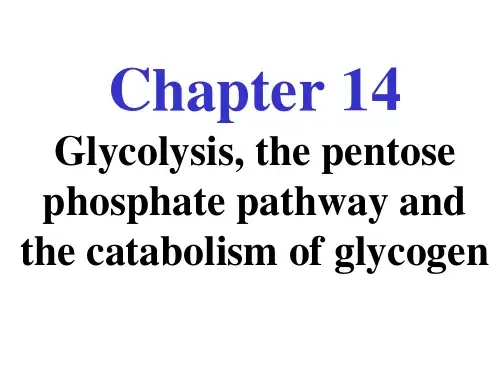
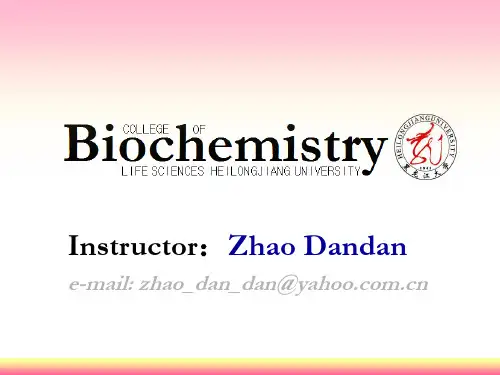
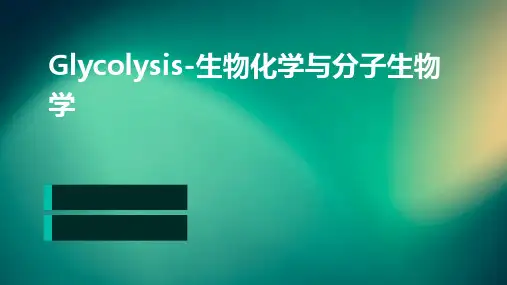
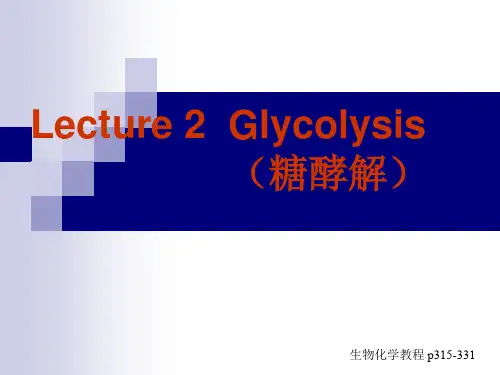
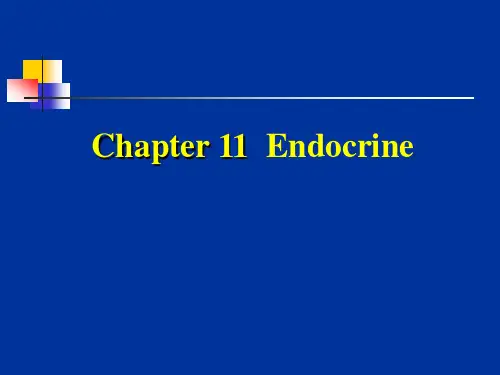
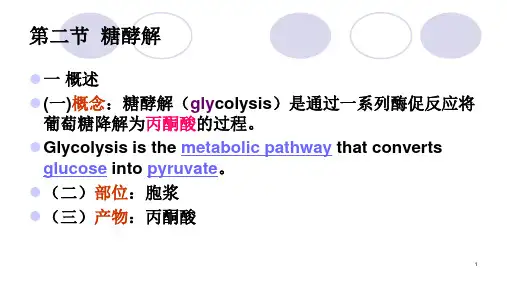
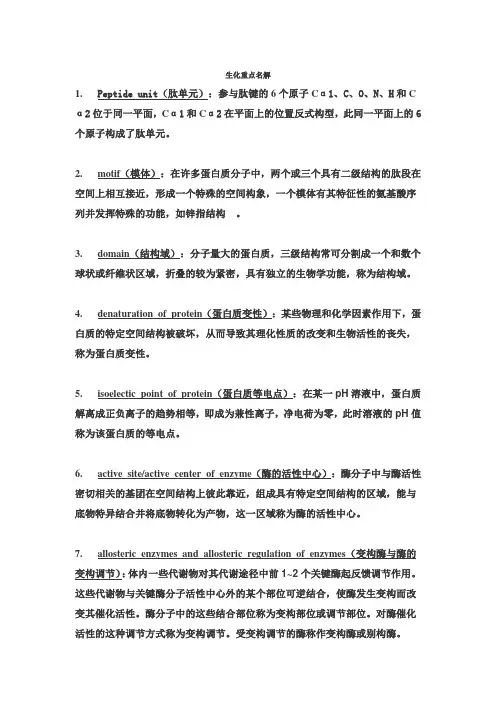
生化重点名解1.Peptide unit(肽单元):参与肽键的6个原子Cα1、C、O、N、H和C α2位于同一平面,Cα1和Cα2在平面上的位置反式构型,此同一平面上的6个原子构成了肽单元。
2.motif(模体):在许多蛋白质分子中,两个或三个具有二级结构的肽段在空间上相互接近,形成一个特殊的空间构象,一个模体有其特征性的氨基酸序列并发挥特殊的功能,如锌指结构。
3.domain(结构域):分子量大的蛋白质,三级结构常可分割成一个和数个球状或纤维状区域,折叠的较为紧密,具有独立的生物学功能,称为结构域。
4.denaturation of protein(蛋白质变性):某些物理和化学因素作用下,蛋白质的特定空间结构被破坏,从而导致其理化性质的改变和生物活性的丧失,称为蛋白质变性。
5.isoelectic point of protein(蛋白质等电点):在某一pH溶液中,蛋白质解离成正负离子的趋势相等,即成为兼性离子,净电荷为零,此时溶液的pH值称为该蛋白质的等电点。
6.active site/active center of enzyme(酶的活性中心):酶分子中与酶活性密切相关的基团在空间结构上彼此靠近,组成具有特定空间结构的区域,能与底物特异结合并将底物转化为产物,这一区域称为酶的活性中心。
7.allosteric enzymes and allosteric regulation of enzymes(变构酶与酶的变构调节):体内一些代谢物对其代谢途径中前1~2个关键酶起反馈调节作用。
这些代谢物与关键酶分子活性中心外的某个部位可逆结合,使酶发生变构而改变其催化活性。
酶分子中的这些结合部位称为变构部位或调节部位。
对酶催化活性的这种调节方式称为变构调节。
受变构调节的酶称作变构酶或别构酶。
8.cvalent modification/chemical modification of enzyme(酶的共价修饰):在其它酶的催化作用下,酶蛋白肽链上的一些基团可与某些化学基团发生可逆的共价结合,从而改变酶的活性,这一过程称为酶的共价修饰。
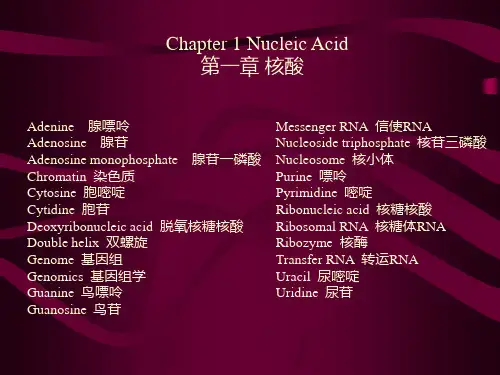
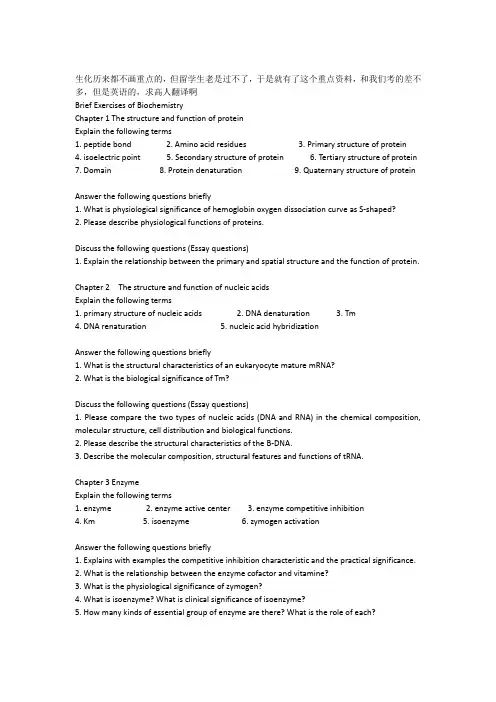
生化历来都不画重点的,但留学生老是过不了,于是就有了这个重点资料,和我们考的差不多,但是英语的,求高人翻译啊Brief Exercises of BiochemistryChapter 1 The structure and function of proteinExplain the following terms1. peptide bond2. Amino acid residues3. Primary structure of protein4. isoelectric point5. Secondary structure of protein6. Tertiary structure of protein7. Domain8. Protein denaturation9. Quaternary structure of proteinAnswer the following questions briefly1. What is physiological significance of hemoglobin oxygen dissociation curve as S-shaped?2. Please describe physiological functions of proteins.Discuss the following questions (Essay questions)1. Explain the relationship between the primary and spatial structure and the function of protein.Chapter 2 The structure and function of nucleic acidsExplain the following terms1. primary structure of nucleic acids2. DNA denaturation3. Tm4. DNA renaturation5. nucleic acid hybridizationAnswer the following questions briefly1. What is the structural characteristics of an eukaryocyte mature mRNA?2. What is the biological significance of Tm?Discuss the following questions (Essay questions)1. Please compare the two types of nucleic acids (DNA and RNA) in the chemical composition, molecular structure, cell distribution and biological functions.2. Please describe the structural characteristics of the B-DNA.3. Describe the molecular composition, structural features and functions of tRNA.Chapter 3 EnzymeExplain the following terms1. enzyme2. enzyme active center3. enzyme competitive inhibition4. Km5. isoenzyme6. zymogen activationAnswer the following questions briefly1. Explains with examples the competitive inhibition characteristic and the practical significance.2. What is the relationship between the enzyme cofactor and vitamine?3. What is the physiological significance of zymogen?4. What is isoenzyme? What is clinical significance of isoenzyme?5. How many kinds of essential group of enzyme are there? What is the role of each?Chapter 4 Metabolism of carbohydrateExplain the following terms1. glycolysis2. glycolytic pathway3. tricarboxylic acid cycle4. gluconeogenesis5. blood sugarAnswer the following questions briefly1. Describe briefly source and fate of blood sugar2. Describe briefly the physiological significance of gluconeogenesis3. Describe briefly the physiological significance of glycolysis4. Describe briefly the outline of TCA cycle5. Describe briefly the physiological significance of TCA cycle6. Describe briefly the physiological significance of pentose phosphate pathway7. Outline the reasons for the formation of lactic acid cycle and the physiological significance.8. Overview the important role of B vitamins in glucose metabolism.9. Why 6-phosphate glucose dehydrogenase activity will increase after uptake high-carbohydrate diet?Discuss the following questions (Essay questions)1. Explain how is lactate converted into glucose? (Write down the main reactions and key enzymes)2. Explain how is lactate converted into CO2, H2O and releases ATP? (Write down the main reactions and key enzymes)3. Overview the regulation molecular mechanism of adrenaline on the blood sugar level.4. Please explain why a slimmer has to reduce the intake of carbohydrates from the point of view of nutrients metabolism. (Write down the related pathways, cellular localization, main reactions and key enzyme)Chapter 5 Metabolism of lipidsExplain the following terms1. fat mobilization2. ketone body3. plasma lipoprotein4. apolipoprotein5. essential fatty acid6. blood lipidsAnswer the following questions briefly1. What is the function of bile acid at lipids digestion?2. What is the physiological significance of ketone body generation?3. What are materials of fatty acid synthesis?4. What is the physiological significance of cholesterol?5. What are the functions of apolipoprotein?Discuss the following questions (Essay questions)1. Describe the sources, chemical composition characteristics and main physiological functions of plasma lipoprotein.2. Explain how is the stearic acid converted into CO2, H2O and releases ATP?3. Please describe the oxidation catabolism process of glycerol generated from fat mobilization4. Explain how is the glycerol converted into glycogen?5. Describe the source and fate of acetyl-CoA?Chapter 6 Biological oxidationExplain the following terms1. biological oxidation2. respiratory chain3. oxidative phosphorylation4. substrate level phosphorylationDiscuss the following questions (Essay questions)1. Write down the sequence of two respiratory chainChapter 7 Metabolism of amino-acidExplain the following terms1. essential amino acid2. deamination of amino acid3. transamination of amino acid4. one carbon unit5. hyperammonemiaAnswer the following questions briefly1. What is the physiological significance of one carbon units?2. What is meaning of PAPS, GABA, SAM and FH4 each?3. Write down the deamination of amino acids in vivo.4. Outline the source and fate of blood ammonia.Discuss the following questions (Essay questions)1. How does a glutamate be oxidized to supply energy? What is the final product?2. What are functions of vitamins B in the metabolism of amino acids?3. Use the alanine as an example, try to explain the gluconeogenesis process of glucogenic amino acids.Chapter 8 Metabolism of nucleotideExplain the following terms1. de novo synthesis pathway of purine nucleotide2. nucleotide antimetaboliteAnswer the following questions briefly1. Outline the biological function of nucleotide.2. Outline the physiological significance of salvage synthesis of purine nucleotide.Discuss the following questions (Essay questions)1. Use the 6-mercaptopurine as an example, please explain the mechanism of antimetabolite.Chapter 10 Biosynthesis of DNAExplain the following terms1. semi-conservative replication2. reverse transcription3. replication4. excision repairing5. frame-shift mutationAnswer the following questions briefly1. Outline the classification and function of prokaryote DNA polymerase.2. Outline the classification and function of eukaryote DNA polymerase.3. Outline the factors causing DNA damage.4. Outline the repairing of DNA damage.5. Outline the central dogma.Discuss the following questions (Essay questions)1. Describe the materials involved in prokaryote DNA replication and their functions in that process.2. Describe the biological significance of mutation.Chapter 11 Biosynthesis of RNAExplain the following terms1. transcription2. posttranscriptional process3. hnRNA4. promoter5. ribozyme6. structure geneAnswer the following questions briefly1. Outline the eukaryote posttranscriptional process.2. Outline the products of three kinds of eukaryote RNA polymerases.Discuss the following questions (Essay questions)1. Describe the similarity and dissimilarity of replication and transcription.Chapter 12 Biosynthesis of proteinExplain the following terms1. translate2. polyribosomes3. genetic code4. degeneracy of codonAnswer the following questions briefly1. Describe briefly the RNAs involved in the protein synthesis and their functions in that process.2. Outline the main features of the genetic code.3. Describe briefly the dissimilarity of translation initiation complex formation of prokaryotes and eukaryotes.Discuss the following questions (Essay questions)1. Describe the materials involved in protein biosynthesis and their functions in that process.3. Please comparing the process of translation of prokaryotes and eukaryotes.Chapter 13 The regulation of gene expressionExplain the following terms1. gene expression2. cis-acting element3. trans-acting factor4. operon5. general transcription factor6. enhancerAnswer the following questions briefly1. What is biological significance of regulation of gene expression?2. Outline the function of each component of operon.3. What characteristics does eukaryotic genome structure have?Discuss the following questions (Essay questions)1. Explain the regulation mechanism of lactose operon.Chapter 14 Gene recombination and gene engineeringExplain the following terms1. restriction endonuclease2. genomic DNA3. vector4. cDNA. library5. genetic engineering6. DNA cloning7. homologous recombinationAnswer the following questions briefly1. What are the main selection criteria of gene vector?2. What is the significance of restriction endonuclease of bacteria themselves?3. At present, How many ways to get target genes?4. Outline the basic process of DNA cloning.Discuss the following questions (Essay questions)1. Why plasmid can be used as the vector of genetic engineering?2. Explain how to connect the foreign gene and the vector.3. What is α-complementary? Explain how to screening recombinant by it using an example.Chapter 15 Cellular signal transductionExplain the following terms1. signal transduction2. receptor3. ligand4. signal transduction pathway5. protein kinase6. second messenger7. G proteinAnswer the following questions briefly1. Describe briefly which protein kinases are regulated by intracellular second messenger.2. Outline the classification of receptor and its chemical signals.3. Describe briefly the basic mode of G protein-coupled receptor (seven transmembrane receptor)-mediated signal transduction.4. Describe briefly the signal transduction pathway of intracellular receptor of steroid hormone.Discuss the following questions (Essay questions)1. How does intracellular receptor play its function?2. Explain the process of the glycogen metabolism regulated by glucagon.3. Use fat mobilization as an example, explain the process of cAMP-protein kinase pathway. Chapter 16 Blood biochemistryExplain the following terms1. 2, 3-BPG shuntAnswer the following questions briefly1. Outline the function of plasma protein.Chapter 17 Liver biochemistrExplain the following terms1 biotransformation 2. primary bile acid 3. secondary bile acid4. bile pigment5. jaundiceAnswer the following questions briefly1. Describe briefly the physiological significance of biotransformation.2. Outline the main physiological functions of bile acids.3. Describe briefly production and blood transportation of bilirubin.Discuss the following questions (Essay questions)1. Describe the influence factor of biotransformation.2. Explain the dissimilarity of unconjugated and conjugated bilirubin.Chapter 18VitaminsExplain the following terms1. vitamin2. lipid-soluble vitamin3. water-soluble vitaminAnswer the following questions briefly1. Outline the biochemical function of vitamin E.2. Describe briefly the biochemical function of vitamin D and its deficiency disease.Discuss the following questions (Essay questions)1. Explain the relationship between the water-soluble vitamin and the coenzyme. Chapter 20 Oncogenes, tumor suppressor genes and growth factorExplain the following terms1. oncogene2. proto-oncogene3. tumor suppressor geneAnswer the following questions briefly1. Describe characteristics of proto-oncogene.2. Describe briefly wild-type p53 tumor suppressor gene mechanism.Chapter 21 The Principle and Application of Common Used Techniques in Molecular Biology Explain the following terms1. probe2. PCR3. Gene diagnosis4. gene therapyDiscuss the following questions (Essay questions)1. Describe the definition, type and application of the blotting technique.2. Describe the PCR reaction principle and the basic steps.。

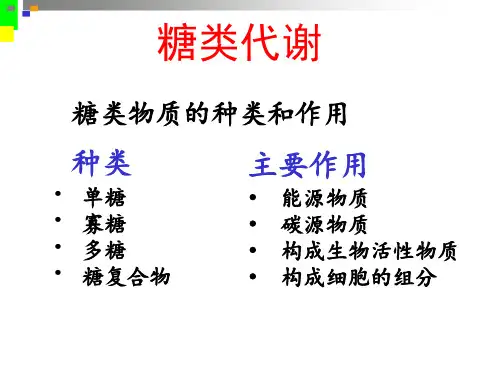
第四章糖代谢【测试题】一、名词解释1.糖酵解(glycolysis)11.糖原累积症2.糖的有氧氧化12.糖酵解途径3.磷酸戊糖途径13.血糖(blood sugar)4.糖异生(glyconoegenesis)14.高血糖(hyperglycemin)5.糖原的合成与分解15.低血糖(hypoglycemin)6.三羧酸循环(krebs循环)16.肾糖阈7.巴斯德效应(Pastuer效应) 17.糖尿病8.丙酮酸羧化支路18.低血糖休克9.乳酸循环(coris循环)19.活性葡萄糖10.三碳途径20.底物循环二、填空题21.葡萄糖在体内主要分解代谢途径有、和。
22.糖酵解反应的进行亚细胞定位是在,最终产物为。
23.糖酵解途径中仅有的脱氢反应是在酶催化下完成的,受氢体是。
两个底物水平磷酸化反应分别由酶和酶催化。
24.肝糖原酵解的关键酶分别是、和丙酮酸激酶。
25.6—磷酸果糖激酶—1最强的变构激活剂是,是由6—磷酸果糖激酶—2催化生成,该酶是一双功能酶同时具有和两种活性。
26.1分子葡萄糖经糖酵解生成分子ATP,净生成分子ATP,其主要生理意义在于。
27.由于成熟红细胞没有,完全依赖供给能量。
28.丙酮酸脱氢酶复合体含有维生素、、、和。
29.三羧酸循环是由与缩合成柠檬酸开始,每循环一次有次脱氢、- 次脱羧和次底物水平磷酸化,共生成分子ATP。
30.在三羧酸循环中催化氧化脱羧的酶分别是和。
31.糖有氧氧化反应的进行亚细胞定位是和。
1分子葡萄糖氧化成CO2和H2O净生成或分子ATP。
32.6—磷酸果糖激酶—1有两个ATP结合位点,一是ATP作为底物结合,另一是与ATP亲和能力较低,需较高浓度ATP才能与之结合。
33.人体主要通过途径,为核酸的生物合成提供。
34.糖原合成与分解的关键酶分别是和。
在糖原分解代谢时肝主要受的调控,而肌肉主要受的调控。
35.因肝脏含有酶,故能使糖原分解成葡萄糖,而肌肉中缺乏此酶,故肌糖原分解增强时,生成增多。
第四章糖代谢【测试题】一、名词解释1.糖酵解(glycolysis)11.糖原累积症2.糖的有氧氧化12.糖酵解途径3.磷酸戊糖途径13.血糖(blood sugar)4.糖异生(glyconoegenesis)14.高血糖(hyperglycemin)5.糖原的合成与分解15.低血糖(hypoglycemin)6.三羧酸循环(krebs循环)16.肾糖阈7.巴斯德效应(Pastuer效应) 17.糖尿病8.丙酮酸羧化支路18.低血糖休克9.乳酸循环(coris循环)19.活性葡萄糖10.三碳途径20.底物循环二、填空题21.葡萄糖在体内主要分解代谢途径有、和。
22.糖酵解反应的进行亚细胞定位是在,最终产物为。
23.糖酵解途径中仅有的脱氢反应是在酶催化下完成的,受氢体是。
两个底物水平磷酸化反应分别由酶和酶催化。
24.肝糖原酵解的关键酶分别是、和丙酮酸激酶。
25.6—磷酸果糖激酶—1最强的变构激活剂是,是由6—磷酸果糖激酶—2催化生成,该酶是一双功能酶同时具有和两种活性。
26.1分子葡萄糖经糖酵解生成分子A TP,净生成分子ATP,其主要生理意义在于。
27.由于成熟红细胞没有,完全依赖供给能量。
28.丙酮酸脱氢酶复合体含有维生素、、、和。
29.三羧酸循环是由与缩合成柠檬酸开始,每循环一次有次脱氢、- 次脱羧和次底物水平磷酸化,共生成分子A TP。
30.在三羧酸循环中催化氧化脱羧的酶分别是和。
31.糖有氧氧化反应的进行亚细胞定位是和。
1分子葡萄糖氧化成CO2和H2O净生成或分子ATP。
32.6—磷酸果糖激酶—1有两个ATP结合位点,一是ATP作为底物结合,另一是与ATP 亲和能力较低,需较高浓度A TP才能与之结合。
33.人体主要通过途径,为核酸的生物合成提供。
34.糖原合成与分解的关键酶分别是和。
在糖原分解代谢时肝主要受的调控,而肌肉主要受的调控。
35.因肝脏含有酶,故能使糖原分解成葡萄糖,而肌肉中缺乏此酶,故肌糖原分解增强时,生成增多。
glycolysis的名词解释Glycolysis:从糖分子到能量的关键道路引言当我们食用食物时,食物中的主要营养物质之一是糖分子。
糖分子是我们身体能够利用的重要能源来源,而将糖分子转化为能量的过程被称为“糖酵解”(glycolysis)。
糖酵解是细胞内最基本的代谢途径之一,为生命体提供了必要的能量和原料。
本文将深入探讨glycolysis的整个过程、涉及的重要酶和关键反应,以及其在人体生理和疾病中的重要性。
1. 糖酵解的过程糖酵解是一个在细胞胞质中进行的过程,其目标是将葡萄糖分子(一个含有6个碳原子的糖分子)转化为两个分子的丙酮酸(一个含有3个碳原子的有机物)。
整个糖酵解过程可以分为三个主要阶段:能量耗散阶段、收集能量阶段和产生能量阶段。
首先,在能量耗散阶段,使用两个ATP分子的能量将葡萄糖分子分解为两个三碳糖分子,即3-磷酸甘油醛(GAP)。
这个过程称为磷酸化反应,由酶磷酸化葡萄糖(hexokinase)催化。
接下来,在收集能量阶段,两个GAP分子进一步转化为两个丙酮酸分子。
这一过程涉及到NAD+(辅酶)的还原,NAD+被还原为NADH。
这个过程包括几个中间产物的生成,例如1,3-二磷酸甘油(1,3-BPG)和3-磷酸甘油酸(3-PG),最终得到两个丙酮酸分子。
此阶段的关键酶包括磷酸甘油脱氢酶(glyceraldehyde-3-phosphate dehydrogenase)和磷酸甘油激酶(phosphoglycerate kinase)。
最后,在产生能量阶段,两个丙酮酸分子进一步分解为乙酰辅酶A(Acetyl-CoA),并且在这个过程中产生了两个ATP分子和两个NADH。
这一阶段包括多个酶的参与,如丙酮酸激酶(pyruvate kinase)和丙酮酸脱羧酶(pyruvate decarboxylase)。
2. 糖酵解酶的重要性上述糖酵解过程中涉及到多个关键酶,这些酶在保障糖酵解能够顺利进行的同时,也在许多生理和病理进程中发挥着重要作用。
Prentice Hall c2002Chapter 111Chapter 11 -Glycolysis•For centuries, bakeries and breweries have exploited theconversion of glucose to ethanol and CO 2by glycolysis in yeastPrentice Hall c2002Chapter 11211.1Glycolysis Is a Ubiquitous PathwayConverts: 1 glucose2 pyruvate•Pyruvate can be further metabolized to:(1) Lactate or ethanol (anaerobic) (2) Acetyl CoA (aerobic) •Acetyl CoA is further oxidized to CO 2and H 2O via the citric acid cycle•Much more ATP is generated from the citric acid cycle than from glycolysisPrentice Hall c2002Chapter 113Fig 11.1•Catabolism of glucose via glycolysis and the citric acid cycle(continued next slide)Prentice Hall c2002Chapter 114Fig 11.1 (continued)Prentice Hall c2002Chapter 115Net reaction of glycolysis •Two molecules of ATP are produced•Two molecules of NAD +are reduced to NADHGlucose + 2 ADP + 2 NAD + + 2 P i2 Pyruvate + 2 ATP + 2 NADH + 2 H ++ 2 H 2OPrentice Hall c2002Chapter 116Table 11.1Prentice Hall c2002Chapter 117Glycolysis (10 reactions) can bedivided into two stages•Hexose stage: 2 ATP are consumed per glucose •Triose stage: 4 ATP are produced per glucoseNet: 2 ATP produced per glucosePrentice Hall c2002Chapter 118Fig 11.2•Glycolysis (next 4 slides)Prentice Hall c2002Chapter 119Phosphofructokinase-1Prentice Hall c2002Chapter 1110Prentice Hall c2002Chapter 1111Prentice Hall c2002Chapter 111211.2Glycolysis Has 10 Enzyme-Catalyzed Steps•Each chemical reaction prepares a substrate for the next step in the process •A hexose is cleaved to two trioses•Interconversion of the trioses allows both to be further metabolized via glycolytic enzymes •ATP is both consumed and produced in glycolysisPrentice Hall c2002Chapter 11131.Hexokinase•Transfers the γ-phosphoryl of ATP to glucose C-6 oxygen to generate glucose 6-phosphate (G6P ) •Mechanism: attack of C-6 hydroxyl oxygen of glucose on the γ-phosphorous of MgATP 2-displacing MgADP -•Four kinases in glycolysis: steps 1,3,7, and 10•All four kinases require Mg 2+and have a similar mechanismPrentice Hall c2002Chapter 1114Fig 11.3Hexokinase reactionPrentice Hall c2002Chapter 1115Properties of hexokinases •Broad substrate specificity -hexokinases can phosphorylate glucose, mannose and fructose •Yeast hexokinase undergoes an induced-fit conformational change when glucose binds •Conformational change helps prevent hydrolysis of ATP to ADP and P i (Fig 6.13)Prentice Hall c2002Chapter 1116Isozymes of hexokinase•Isozymes -multiple forms of hexokinase occur in mammalian tissues and yeast•Hexokinases I, II, III are active at normal glucose concentrations (K m values ~10-6to 10-4M)•Hexokinase IV (Glucokinase , K m ~10-2M) isactive at higher glucose levels, allows the liver to respond to large increases in blood glucosePrentice Hall c2002Chapter 11172. Glucose 6-Phosphate Isomerase•Converts glucose 6-phosphate (G6P ) (analdose) to fructose 6-phosphate (F6P ) (a ketose)•Enzyme preferentially binds the α-anomer of G6P (converts to open chain form in the active site) •Enzyme is highly stereospecific for G6P and F6P •Isomerase reaction is near-equilibrium in cellsPrentice Hall c2002Chapter 1118Fig 11.4 Conversion of G6P to F6PPrentice Hall c2002Chapter 11193.Phosphofructokinase-1 (PFK-1)•Catalyzes transfer of a phosphoryl group from ATP to the C-1 hydroxyl group of F6P to form fructose 1,6-bis phosphate (F1,6BP )•PFK-1 is metabolically irreversible and a critical regulatory point for glycolysis in most cells (PFK-1 is the first committed step of glycolysis)•A second phosphofructokinase (PFK-2)synthesizes fructose 2,6-bis phosphate (F2,6BP )Prentice Hall c2002Chapter 1120PFK-1 ReactionPrentice Hall c2002Chapter 11214.Aldolase•Aldolase cleaves the hexose F1,6BP into two triose phosphates:glyceraldehyde 3-phosphate (GAP ) and dihydroxyacetone phosphate (DHAP )•Reaction is near-equilibrium, not a control point •Mechanism is common for cleaving C-C bonds in biological systems (and C-C bond formation in the reverse direction)Prentice Hall c2002Chapter 1122Aldolase ReactionPrentice Hall c2002Chapter 1123Fig 11.5 Mechanism of aldolases(continued next slide)Prentice Hall c2002Chapter 1124Fig 11.5 (continued)Prentice Hall c2002Chapter 11255.Triose Phosphate Isomerase (TPI)•Conversion of DHAP into glyceraldehyde 3-phosphate (GAP)•Reaction is very fast (diffusion controlled), and only the D-isomer of GAP is formed•Radioisotopic tracer studies show:One GAP molecule: C1,2,3 from Glucose C4,5,6Second GAP: C1,2,3 from Glucose C3,2,1Prentice Hall c2002Chapter 1126Reaction of Triosephosphate isomerasePrentice Hall c2002Chapter 1127Fig 11.6 Fate of carbon atoms fromhexose stage to triose stagePrentice Hall c2002Chapter 11286.Glyceraldehyde 3-PhosphateDehydrogenase (GAPDH)•Conversion of GAP to1,3-bis phosphoglycerate (1,3BPG )•Molecule of NAD +is reduced to NADH•Oxidation of the aldehyde group of GAPproceeds with large negative free-energy changePrentice Hall c2002Chapter 1129Conservation of oxidative energy•Energy from oxidation of GAP aldehyde is conserved in acid-anhydride linkage of 1,3BPG •Next step of glycolysis uses the high-energy phosphate of 1,3BPG to form ATP from ADP •Mechanism of GAPDH shows how an energy-rich compound forms in an oxidation reactionPrentice Hall c2002Chapter 1130Reaction of GAPDH: GAP converted to 1,3BPGPrentice Hall c2002Chapter 1131Fig 11.7•Mechanism of GAPDH (3 slides)Prentice Hall c2002Chapter 1132Fig 11.7 (continued)(2)(4)Prentice Hall c2002Chapter 1133Fig 11.7 (continued)Prentice Hall c2002Chapter 1134Box 11.2 Arsenate (AsO 43-) poisoning•Arsenate can replace P i as a substrate for G3PDH •Arseno analog which forms is unstablePrentice Hall c2002Chapter 11357.Phosphoglycerate Kinase (PGK)•Transfer of phosphoryl group from the energy-rich mixed anhydride 1,3BPG to ADP yields ATP and 3-phosphoglycerate (3PG )•Substrate-level phosphorylation -Steps 6 and 7 couple oxidation of an aldehyde to a carboxylic acid with the phosphorylation of ADP to ATPPrentice Hall c2002Chapter 1136Phosphoglycerate kinase reactionPrentice Hall c2002Chapter 11378.Phosphoglycerate Mutase•Catalyzes transfer of a phosphoryl group from one part of a substrate molecule to another •Reaction occurs without input of ATP energy •Mechanism requires 2 phosphoryl-group transfer steps•Enzymes from animal muscle and yeast have a different mechanism than does plant enzymePrentice Hall c2002Chapter 1138Phosphoglycerate mutase reactionPrentice Hall c2002Chapter 1139Fig 11.8Phosphoglycerate mutasemechanism: animals and yeast(continued)Prentice Hall c2002Chapter 1140Fig 11.8 (continued)(1)Prentice Hall c2002Chapter 1141Fig 11.8 (continued)Prentice Hall c2002Chapter 11429.Enolase: 2PG to PEP•3-Phosphoglycerate (3PG ) is dehydrated to phosphoenolpyruvate (PEP )•Elimination of water from C-2 and C-3 yields the enol-phosphate PEP•PEP has a very high phosphoryl group transfer potential because it exists in its unstable enol formPrentice Hall c2002Chapter 1143Enolase reactionPrentice Hall c2002Chapter 114410.Pyruvate Kinase (PK)•Catalyzes a substrate-level phosphorylation •Metabolically irreversible reaction•Regulation both by allosteric modulators and by covalent modification•Pyruvate kinase gene can be regulated by various hormones and nutrientsPEP + ADPPyruvate + ATPPrentice Hall c2002Chapter 1145Fig 11.9•Pyruvate kinase reactionPrentice Hall c2002Chapter 114611.3The Fate of Pyruvate1. Aerobic conditions: oxidized to acetyl CoA which enters the citric acid cycle for further oxidation2. Anaerobic conditions (microorganisms): conversion to ethanol3. Anaerobic conditions (muscles, red blood cells): conversion to lactatePrentice Hall c2002Chapter 1147Fig 11.10•Three major fates of pyruvatePrentice Hall c2002Chapter 1148A. Metabolism of Pyruvate to Ethanol(yeast -anaerobic)•Two reactions required: (1) Pyruvate carboxylase (2) Alcohol dehydrogenase PyruvateAcetaldehyde Ethanol(1)(2)Prentice Hall c2002Chapter 1149Fig 11.11•Anaerobic conversion ofpyruvate to ethanol (yeast)Prentice Hall c2002Chapter 1150Fig 11.11 (cont)Prentice Hall c2002Chapter 1151B. Reduction of Pyruvate to Lactate(muscles -anaerobic)•Muscles lack pyruvate dehydrogenase and cannot produce ethanol from pyruvate •Muscle lactate dehydrogenase converts pyruvate to lactate•This reaction regenerates NAD +for use by GAPDH in glycolysisPrentice Hall c2002Chapter 1152Recycling of lactate•Lactate formed in skeletal muscles during exercise is transported to the liver •Liver lactate dehydrogenase can reconvert lactate to pyruvate•Lactic acidosis can result from insufficientoxygen (an increase in lactic acid and decrease in blood pH)Prentice Hall c2002Chapter 1153Reduction of pyruvate to lactatePrentice Hall c2002Chapter 1154Overall reactions for glucosedegradation to lactate•Two ATP per molecule glucose consumed •No oxygen is required Glucose + 2 P i 2-+ 2 ADP 3-2 Lactate -+ 2 ATP 4-+ 2 H 2OPrentice Hall c2002Chapter 115511.4Free-Energy Changes in Glycolysis•Actual free-energy changes (∆G) large only for:#1 (hexokinase)#3 (phosphofructokinase)#10 (pyruvate kinase)•These steps are metabolically irreversible, and these enzymes are regulated•∆G for all other steps are close to zero (they are near-equilibrium in cells)Prentice Hall c2002Chapter 1156Fig 11.12 Cumulative standard and actual free energy changes for the reactions of glycolysisPrentice Hall c2002Chapter 115711.5Regulation of Glycolysis1. When ATP is needed, glycolysis is activated •AMP and fructose 2,6-bis phosphate (F2,6BP) relieve the inhibition of PFK-1 by ATP2. When ATP levels are sufficient,glycolysis activity decreases •PFK-1 is inhibited by ATP and citrate•Hexokinase inhibited by excess glucose 6-phosphatePrentice Hall c2002Chapter 1158Fig 11.13 Metabolic regulation of glycolysis(continued)Prentice Hall c2002Chapter 1159Fig 11.13 (continued)Prentice Hall c2002Chapter 1160A. Regulation of Hexose Transporters•Glucose enters mammalian cells by passivetransport down a concentration gradient from blood to cells•GLUT is a family of six passive hexose transporters •Glucose uptake into skeletal and heart muscle and adipocytes by GLUT 4 is stimulated by insulin •Other GLUT transporters mediate glucose transport in and out of cells in the absence of insulinPrentice Hall c2002Chapter 1161Fig 11.14 Regulation of glucosetransport by insulinPrentice Hall c2002Chapter 1162B. Regulation of Hexokinase•Hexokinase reaction is metabolically irreversible •G6P (product) levels increase when glycolysis is inhibited at sites further along in the pathway •G6P inhibits hexokinase isozymes I, II and III •Glucokinase forms G6P in the liver (for glycogen synthesis) when glucose is abundant (activity is modulated by fructose phosphates and a regulatory protein)Prentice Hall c2002Chapter 1163Fig 11.15 Effects of a regulatory proteinon glucokinase kinetics•Addition of aregulatory protein raises apparent K m for glucose (inhibits glucokinase)Prentice Hall c2002Chapter 1164Box 11.3 Glucose 6-Phosphate Has aPivotal Metabolic Role in LiverPrentice Hall c2002Chapter 1165C. Regulation of Phosphofructokinase-1•ATP is a substrate and an allosteric inhibitor of PFK-1•AMP allosterically activates PFK-1 by relieving the ATP inhibition (ADP is also an activator in mammalian systems)•Changes in AMP and ADP concentrations can control the flux through PFK-1•Elevated levels of citrate (indicate ample substrates for citric acid cycle) also inhibit PFK-1Prentice Hall c2002Chapter 1166Fig 11.16 Regulation of PFK-1 by ATP and AMP•AMP relieves ATP inhibition of PFK-1Prentice Hall c2002Chapter 1167Regulation of PFK-1 by Fructose 2,6-bis phosphate (F2,6BP)•F2,6BP is formed from F6P by the enzyme phosphofructokinase-2 (PFK-2)•Fig 11.17β-D-Fructose 2,6-bis phosphatePrentice Hall c2002Chapter 1168Formation and hydrolysis of F2,6BPPrentice Hall c2002Chapter 1169Fig. 11.18•Effect of glucagon on liver glycolysisPrentice Hall c2002Chapter 1170D. Regulation of Pyruvate Kinase (PK)•Four PK isozymes exist in mammalian tissues •PK is allosterically activated by F1,6BP,inhibited by ATP•Glucagon stimulates protein kinase A which phosphorylates PK converting it to a less active form (liver and intestinal cells)Prentice Hall c2002Chapter 1171Fig 11.19 Initial velocity curves ofpyruvate kinasePrentice Hall c2002Chapter 1172Fig 11.20Pyruvate kinase with F1,6BP•Activator F1,6BP (red)•Active site is in large central domainPrentice Hall c2002Chapter 1173E. The Pasteur Effect•Under anaerobic conditions the conversion of glucose to pyruvate is much higher than under aerobic conditions (yeast cells produce more ethanol and muscle cells accumulate lactate)•The Pasteur Effect is the slowing of glycolysis in the presence of oxygen•More ATP is produced under aerobic conditions than under anaerobic conditions, therefore less glucose is consumed aerobicallyPrentice Hall c2002Chapter 117411.6Other Sugars Can Enter Glycolysis•Glucose is the main metabolic fuel in most organisms •Other sugars convert to glycolytic intermediates •Fructose and sucrose (contains fructose) are major sweeteners in many foods and beverages •Galactose from milk lactose (a disaccharide) •Mannose from dietary polysaccharides,glycoproteinsPrentice Hall c2002Chapter 1175A. Fructose Is Converted to Glyceraldehyde 3-PhosphateFig 11.21(continued)Prentice Hall c2002Chapter 1176Fig 11.21 (continued)Prentice Hall c2002Chapter 1177B.Galactose is Converted toGlucose 1-PhosphateFig 11.22 (continued next slide)Prentice Hall c2002Chapter 1178Fig 11.22 (continued)Prentice Hall c2002Chapter 1179C. Mannose is Converted to Fructose 6-PhosphatePrentice Hall c2002Chapter 118011.7Formation of 2,3-Bis phosphoglyceratein Red Blood Cells•2,3-Bis phosphoglycerate (2,3BPG)allosterically regulates hemoglobin oxygenation (red blood cells)•Erythrocytes contain bis phosphoglycerate mutase which forms 2,3BPG from 1,3BPG•In red blood cells about 20% of the glycolytic flux is diverted for the production of the important oxygen regulator 2,3BPGFig 11.24•Formationof 2,3BPGin red bloodcellsPrentice Hall c2002Chapter 1181。